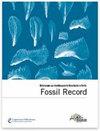始新世波罗的海琥珀中Cathartosilvanus的第二个化石物种
IF 2.1
4区 地球科学
Q1 PALEONTOLOGY
引用次数: 3
摘要
摘要描述了波罗的海琥珀中一种新的银科扁树皮甲虫属cathartosilvanus Grouvelle。Cathartosilvanus siteiteralevis sp. 11 .与最近的和化石的同类不同,在其后前角处发现的明显的,锋利的小齿。在琥珀埋藏学的背景下,简要讨论和解释了特定身体部位断开的现象,以及标本的压缩。正在研究的标本似乎是一个罕见的例子,一个弱硬化的甲虫图像在蜕皮后不久就被困在树脂中。本文章由计算机程序翻译,如有差异,请以英文原文为准。
The second fossil species of Cathartosilvanus (Coleoptera: Cucujoidea: Silvanidae) from Eocene Baltic amber
Abstract. A new fossil species of the silvanid flat bark beetle genus
Cathartosilvanus Grouvelle is described and illustrated from Baltic amber. Cathartosilvanus siteiterralevis sp. nov. differs
from recent and fossil congeners in the distinct, sharp denticle found along
its posterior pronotal angle. The phenomenon of specific body parts becoming
disconnected, and the compression of specimens is briefly discussed and
interpreted in the context of amber taphonomy. The specimen under study
appears to be an uncommon case of a weakly sclerotized beetle imago becoming
entrapped in resin shortly after moulting.
求助全文
通过发布文献求助,成功后即可免费获取论文全文。
去求助
来源期刊

Fossil Record
PALEONTOLOGY-
CiteScore
3.60
自引率
7.10%
发文量
18
审稿时长
14 weeks
期刊介绍:
Fossil Record (FR) is the palaeontological journal of the Museum für Naturkunde Berlin. This journal was founded in 1998 under the name Mitteilungen aus dem Museum für Naturkunde Berlin, Geowissenschaftliche Reihe and appears with two issues each year. Fossil Record publishes original papers in all areas of palaeontology including the taxonomy and systematics of fossil organisms, biostratigraphy, palaeoecology, and evolution. All taxonomic groups are treated, including invertebrates, microfossils, plants, and vertebrates.
 求助内容:
求助内容: 应助结果提醒方式:
应助结果提醒方式:


